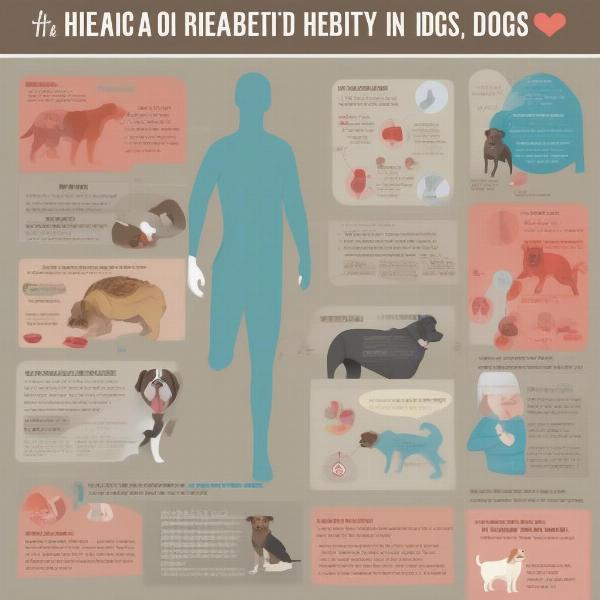The term “chunky dog” isn’t a specific breed but a loving descriptor for dogs carrying a little extra weight. While a cuddly physique might seem endearing, it’s crucial to understand the implications for your dog’s health and well-being. This article delves into the reasons behind chunkiness in dogs, exploring breed predispositions, dietary factors, and the importance of maintaining a healthy weight for a happy, active life. We’ll cover everything from recognizing healthy weight ranges to providing practical tips for exercise and nutrition.
Is My Dog Chunky? Assessing Your Dog’s Weight
Determining if your dog is overweight involves more than just a visual assessment. While certain breeds are naturally more robust, excess weight can negatively impact any dog’s health. Feel for your dog’s ribs – you should be able to feel them easily without pressing hard. A visible waistline when viewed from above and a tucked-up abdomen from the side are also good indicators of a healthy weight. If your dog’s ribs are difficult to feel, their waistline is absent, or their belly hangs low, it’s time to address their weight.
Breed Predispositions to Weight Gain
Some breeds are genetically predisposed to weight gain, such as Labrador Retrievers, Beagles, and Pugs. These breeds often have hearty appetites coupled with slower metabolisms, making them prone to packing on the pounds. Understanding your dog’s breed-specific tendencies is key to tailoring their diet and exercise regimen accordingly. This doesn’t mean these breeds are destined to be overweight; it simply means they require extra attention to portion control and consistent activity.
The Role of Diet in a Chunky Dog
Diet plays a pivotal role in managing a dog’s weight. Overfeeding, even with healthy food, can lead to weight gain. Just like humans, dogs need a balanced diet that provides the right amount of calories, protein, fats, and carbohydrates. High-calorie treats should be given sparingly, and portion sizes should be adjusted based on your dog’s age, activity level, and breed.
Exercise: Keeping Your Chunky Dog Active
Regular exercise is essential for maintaining a healthy weight and overall well-being in dogs. The type and amount of exercise will vary depending on the breed, age, and health condition. Daily walks, playtime in the park, or even a game of fetch in the backyard can contribute significantly to burning calories and keeping your dog fit. For breeds prone to joint issues, swimming is a low-impact exercise option that’s gentle on their joints.
Health Risks Associated with Obesity in Dogs
Obesity in dogs can lead to several health problems, including diabetes, heart disease, arthritis, and even certain types of cancer. Maintaining a healthy weight is not just about aesthetics; it’s about ensuring your dog lives a long, healthy, and active life. By addressing weight issues early on, you can significantly reduce the risk of these serious health conditions.
 Overweight Dog Health Risks
Overweight Dog Health Risks
What to Do If Your Dog Is Overweight
If you suspect your dog is overweight, consult your veterinarian. They can assess your dog’s overall health, determine their ideal weight, and recommend a safe and effective weight loss plan. This plan will likely involve a combination of dietary changes and increased exercise. Never put your dog on a drastic diet without veterinary guidance, as this can be harmful.
Conclusion: Embracing a Healthy Lifestyle for Your Chunky Dog
While the term “chunky dog” may evoke images of adorable rolls, it’s important to remember that maintaining a healthy weight is vital for your dog’s overall well-being. By understanding breed predispositions, dietary needs, and the importance of regular exercise, you can help your chunky dog achieve a healthy weight and enjoy a long, happy, and active life.
FAQ:
- How can I tell if my dog is overweight? You should be able to feel your dog’s ribs easily without pressing hard. A visible waistline and tucked-up abdomen are also good indicators.
- Are certain breeds more prone to weight gain? Yes, breeds like Labradors, Beagles, and Pugs are genetically predisposed to weight gain.
- What are the health risks of obesity in dogs? Obesity can lead to diabetes, heart disease, arthritis, and certain cancers.
- How can I help my dog lose weight? Consult your veterinarian for a safe and effective weight loss plan involving diet and exercise.
- What kind of exercise is good for an overweight dog? Daily walks, playtime, fetch, and swimming are all good options.
- How often should I feed my dog? Consult your vet for breed-specific recommendations, but most adult dogs thrive on two meals a day.
- What should I do if my dog suddenly gains weight? Consult your veterinarian to rule out any underlying medical conditions.
Related Articles:
chunky dog roll
superior chunky dog roll
dog christmas sweater for humans
dog jumper knitting patterns
About ILM Dog:
ILM Dog provides expert advice and resources on all aspects of dog care, from breed selection and health to training, nutrition, and grooming. Whether you’re a new dog owner or a seasoned expert, we offer practical tips and insights to help you provide the best possible care for your furry friend. We cover a wide range of topics including choosing the right dog breed for you, understanding dog health and medical care, effective training techniques, balanced nutrition, and proper grooming practices. For personalized advice and guidance, contact us via email at [email protected] or call us at +44 20-3965-8624.